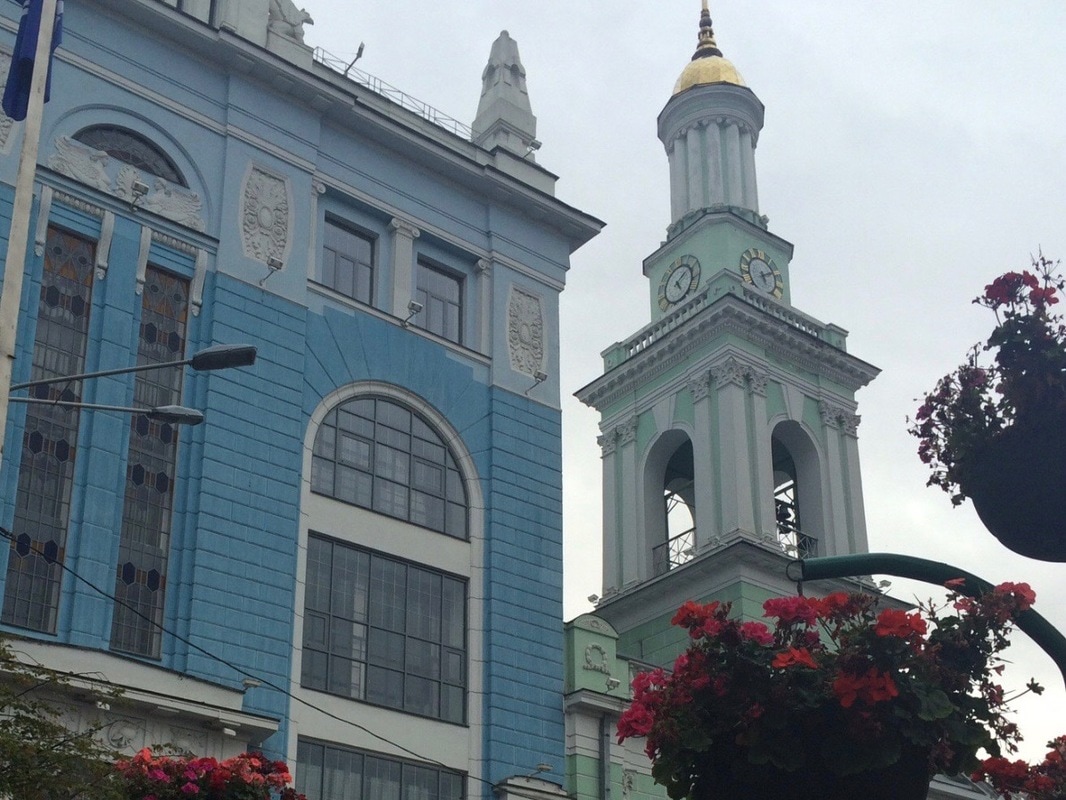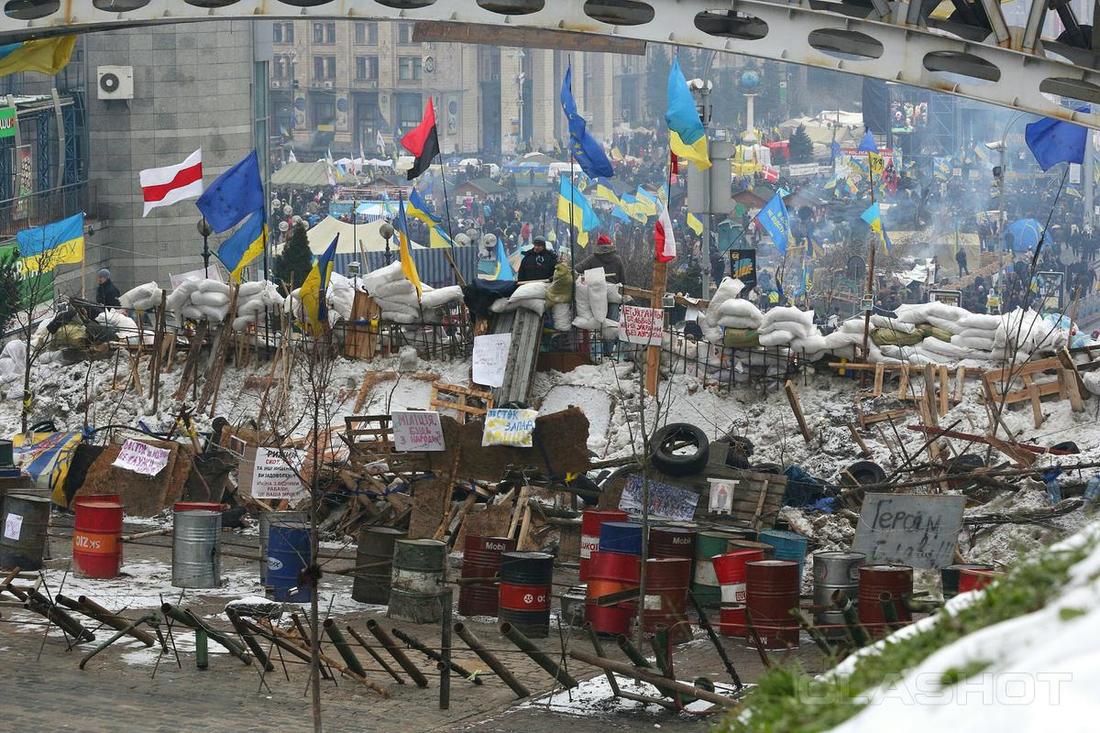Action and reaction, the art of politics and political art in Ukraine. Part two
On my last evening I was taken by my hosts to a Jewish restaurant in Podil, a gentle neighbourhood of fading grandeur with restaurants, tree lined squares and a lively energy.
The busy market sells fruit and herbs and hand knitted socks, and the glitzy supermarket European biscuits and caviar. The British Council offices were just around the corner.
I asked for a local drink and they suggested I try vodka with horseradish – 38% proof with a fiery start and a textured end. Over a Jewish meze and our second small flask of vodka, the conversation turned to language and ethnicity.
We were 7 artists and producers of whom 6 were Ukrainian. They came from across this vast country and had studied both in Ukraine and abroad. Most had traveled widely and their English was near perfect. They were ethnically Ukrainian, Russian and Jewish and one had a Polish boyfriend. Their parentage was mixed and they still had friends in Crimea and Donetsk.
My few days in Kiev had already taught me that on the streets and in the houses, the offices, museums and galleries Russian and Ukrainian languages are interchangeable. There are no signals, at least to the outsider, that one or other of the languages will be spoken and there is a quiet expectation that you will understand both.
I heard for the second time this trip, that the war in Donbass was not an “ethnic issue” – it was a “Russia issue”, and that the divide between people was not a division of ethnicity, but a division caused by politics and Russian expansionism.
My new friends were born in Soviet times. In the world of their youth to get ahead you became first a Pioneer, then a Komsomol, and only then would you have access to the benefits of the party. In their schools they were taught about Soviet culture in Russian, and Ukrainian writers were celebrated as talented Soviets. Indeed the glorious socialist realist murals in the 1956 Expocenter depict Ukrainian endeavor as second only to Russia herself.
It took the collapse of the Soviet Union in the early 1990’s for Ukraine to become an independent county. What’s followed was the Ukrainisation of Ukraine where the official language became Ukrainian, the colours of the flag became widely visible in public life and new business and political leaders attempted to redefine the country’s soul.
In schools, in today’s Ukraine, Russian books have stopped being taught as national texts and are taught instead as foreign literature alongside other international authors in translation. My colleagues’ opposing views rolled back and forth across the table…
‘Is it not right for Ukrainian children to learn in Ukrainian?” ‘But surely any literature is best read its original text? “ “Did I not understand that if you go to a bookshop, even today, most books will be in Russian?” “Yes but what would be lost if all children just spoke Ukrainian, will it not make our children more insular?” ‘But surely we need a period when we break the hegemony of the Russian language?” “But if that happens, are we not just throwing away a given multiculturalism which will, in the long run, make us stronger.” ‘This should not be an argument. We should appreciate the art and not restrict our access to it for political purposes.”
As I sipped my vodka I felt honored to be part of these conversations and privileged to have the opportunity to come back to spend more time with these new friends…
In 2015 Clymene took part in the British Council Canny Creative Fellowship in Kyiv, Ukraine. The fellowship placed her with the Congress of Cultural Activists and CSM, Contemporary Arts Institute. These blogs reflect her brief time embedded in the culture and politics of Ukraine.
On my last evening I was taken by my hosts to a Jewish restaurant in Podil, a gentle neighbourhood of fading grandeur with restaurants, tree lined squares and a lively energy.
The busy market sells fruit and herbs and hand knitted socks, and the glitzy supermarket European biscuits and caviar. The British Council offices were just around the corner.
I asked for a local drink and they suggested I try vodka with horseradish – 38% proof with a fiery start and a textured end. Over a Jewish meze and our second small flask of vodka, the conversation turned to language and ethnicity.
We were 7 artists and producers of whom 6 were Ukrainian. They came from across this vast country and had studied both in Ukraine and abroad. Most had traveled widely and their English was near perfect. They were ethnically Ukrainian, Russian and Jewish and one had a Polish boyfriend. Their parentage was mixed and they still had friends in Crimea and Donetsk.
My few days in Kiev had already taught me that on the streets and in the houses, the offices, museums and galleries Russian and Ukrainian languages are interchangeable. There are no signals, at least to the outsider, that one or other of the languages will be spoken and there is a quiet expectation that you will understand both.
I heard for the second time this trip, that the war in Donbass was not an “ethnic issue” – it was a “Russia issue”, and that the divide between people was not a division of ethnicity, but a division caused by politics and Russian expansionism.
My new friends were born in Soviet times. In the world of their youth to get ahead you became first a Pioneer, then a Komsomol, and only then would you have access to the benefits of the party. In their schools they were taught about Soviet culture in Russian, and Ukrainian writers were celebrated as talented Soviets. Indeed the glorious socialist realist murals in the 1956 Expocenter depict Ukrainian endeavor as second only to Russia herself.
It took the collapse of the Soviet Union in the early 1990’s for Ukraine to become an independent county. What’s followed was the Ukrainisation of Ukraine where the official language became Ukrainian, the colours of the flag became widely visible in public life and new business and political leaders attempted to redefine the country’s soul.
In schools, in today’s Ukraine, Russian books have stopped being taught as national texts and are taught instead as foreign literature alongside other international authors in translation. My colleagues’ opposing views rolled back and forth across the table…
‘Is it not right for Ukrainian children to learn in Ukrainian?” ‘But surely any literature is best read its original text? “ “Did I not understand that if you go to a bookshop, even today, most books will be in Russian?” “Yes but what would be lost if all children just spoke Ukrainian, will it not make our children more insular?” ‘But surely we need a period when we break the hegemony of the Russian language?” “But if that happens, are we not just throwing away a given multiculturalism which will, in the long run, make us stronger.” ‘This should not be an argument. We should appreciate the art and not restrict our access to it for political purposes.”
As I sipped my vodka I felt honored to be part of these conversations and privileged to have the opportunity to come back to spend more time with these new friends…
In 2015 Clymene took part in the British Council Canny Creative Fellowship in Kyiv, Ukraine. The fellowship placed her with the Congress of Cultural Activists and CSM, Contemporary Arts Institute. These blogs reflect her brief time embedded in the culture and politics of Ukraine.



 RSS Feed
RSS Feed